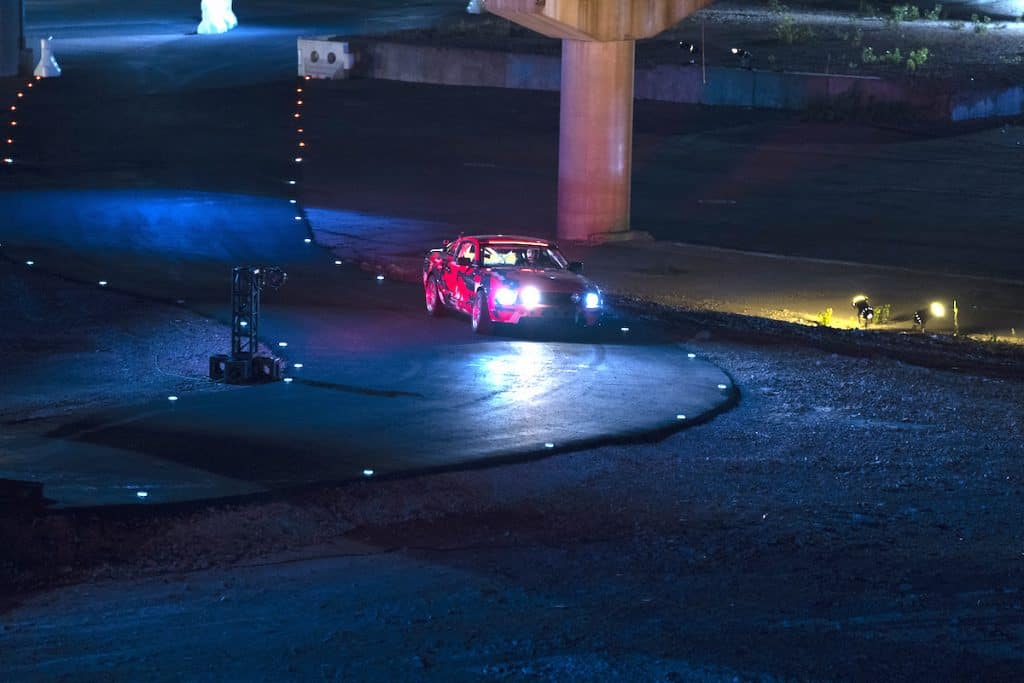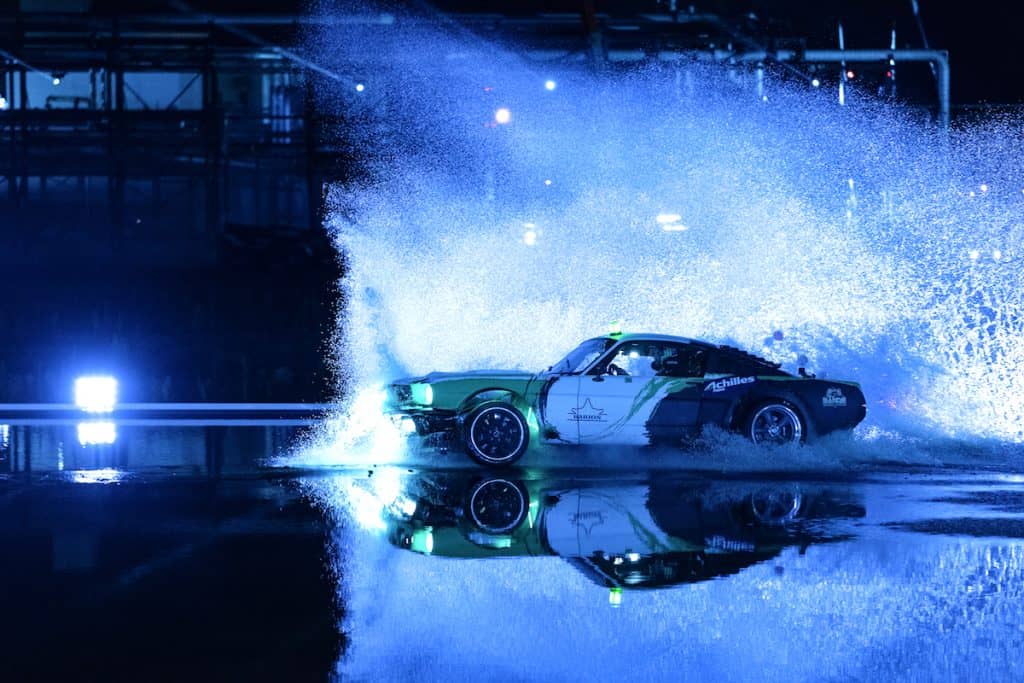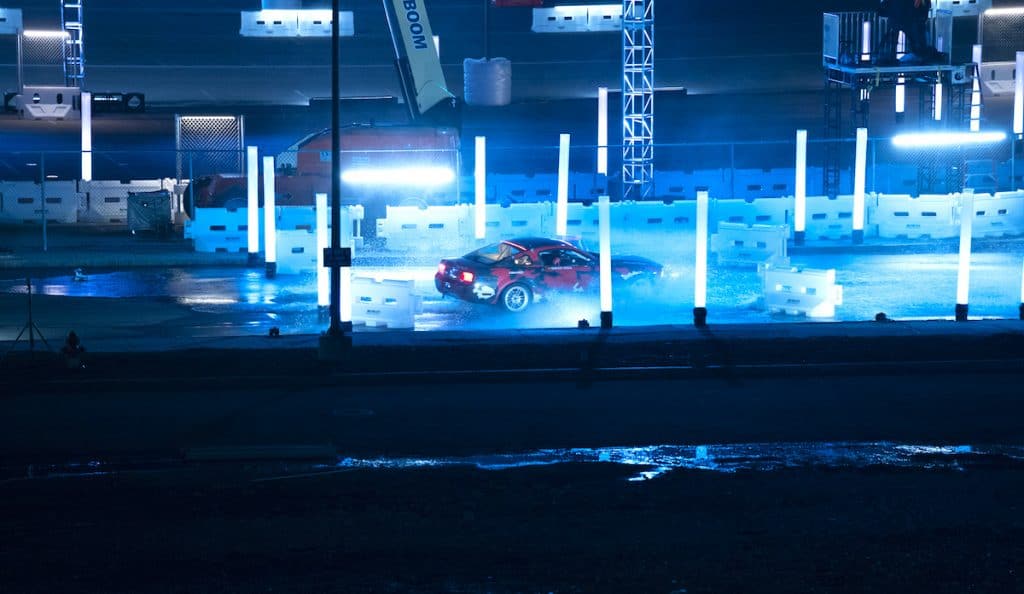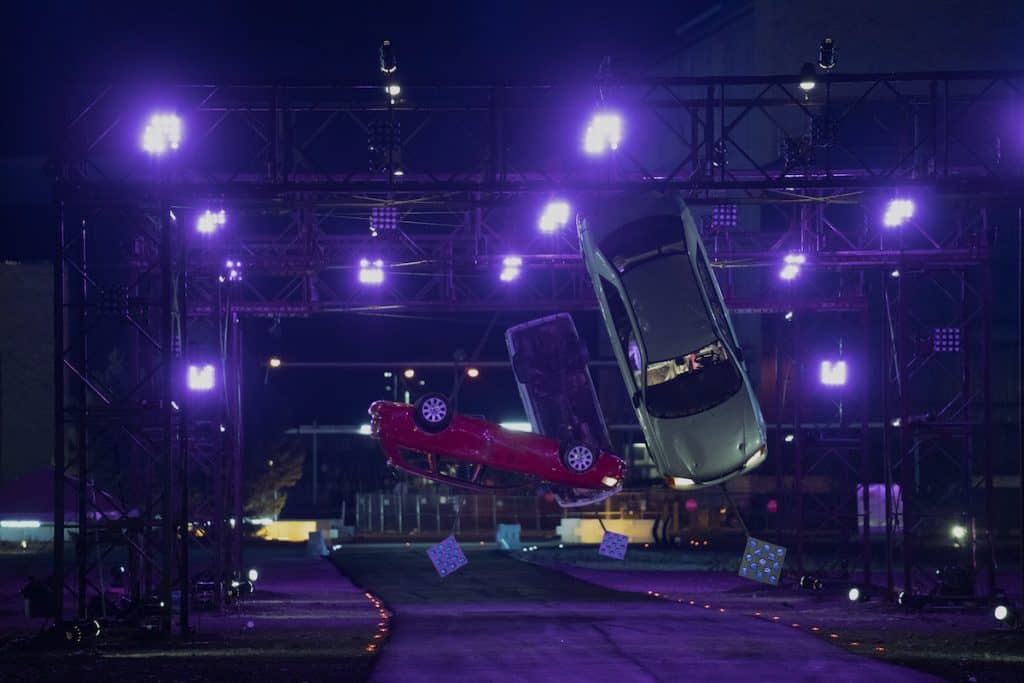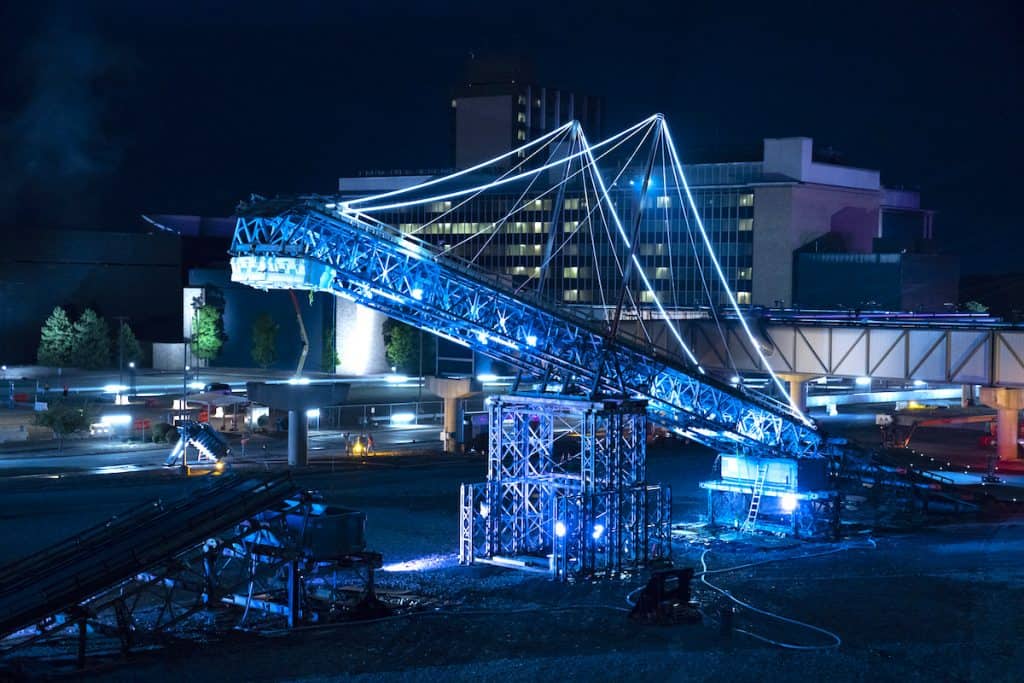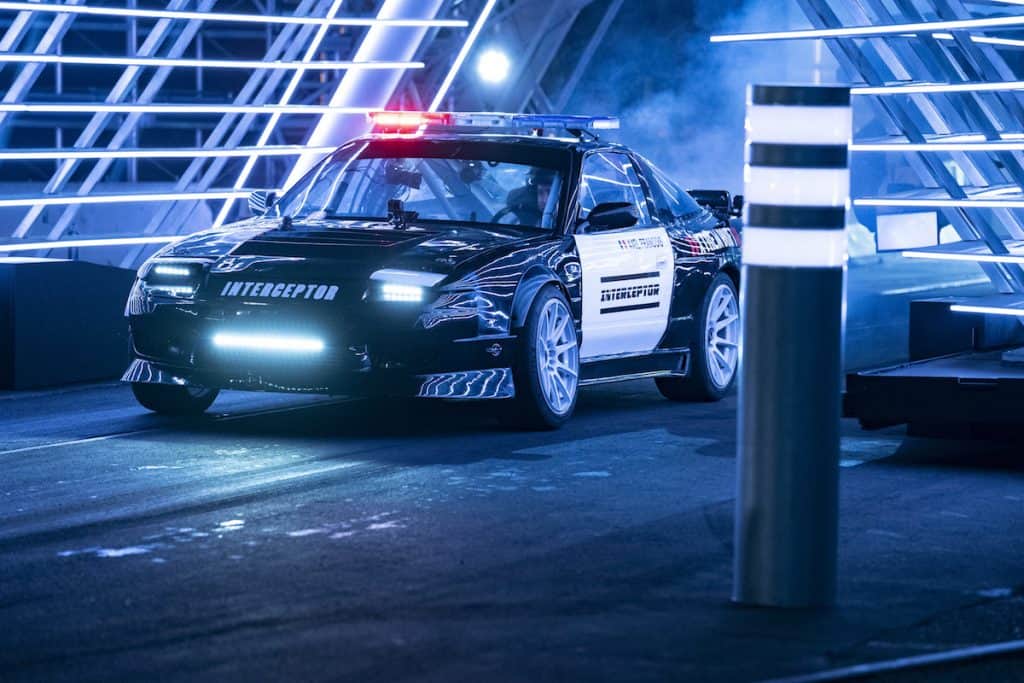ICG Magazine: Wheels of Steel, by David Geffner
How best to describe Hyperdrive to a reality TV fan? Imagining an unlikely (but spectacular) amalgam of three diverse cultural icons – NASCAR, Blade Runner, and American Ninja Warrior – is a good start. Ensuring that the inherent dangers (for both contestant and crew) of a show with vehicles traveling more than 90 mph are minimized and/or nearly eliminated is another road down which this one-of-a-kind unscripted show travels.
Hyperdrive, at its core, is an automotive spectacle, similar to America’s most popular televised race series, NASCAR, where the combination of speed and lightning-quick decisions mean disaster is ever-present. And, like NASCAR, Hyperdrive benefited from the highly specialized work of Broadcast Sports International (BSI), which pioneered onboard action cams. BSI’s 13-person team installed six to eight GoPros (shooting 4K linear footage) around each racer’s car, and two Blackmagic Design 4K cameras (with ARRI/Fujinon zooms) inside each vehicle, as well as RF audio feeds back to the mobile production truck.
But that’s mostly where the similarities end. Hyperdrive contestants (hailing from Japan, Brazil, Poland, Germany, and the U.S.) are “drifters,” who intentionally over-steer their vehicles at high speed (typically losing traction in just the rear wheels), while navigating a series of obstacles à la American Ninja Warrior. Like Ninja, each obstacle is named, often for its degree of ferocity –– “Supernova,” “The Water Canon,” “Pipe City,” “The Gauntlet,” and the show’s most iconic obstacle, “The Leveler,” which looms over the course like a T-Rex waiting to gobble up the (comparatively) Tonka toy-sized race cars.
Director of Photography/Lighting Designer Adam Biggs says that because they couldn’t light every “square foot” of the 112-acre Eastman-Kodak Film Processing Plant, in Rochester, NY, “the mantra was to make darkness our friend.”
As for Blade Runner, that look came courtesy of Director of Photography/Lighting Designer Adam Biggs, who made the most of an epic location – the former Kodak film processing plant in Rochester, NY. Biggs bathed the 112-acre “film set” in a stark, steam-punk feel – menacing blues, grays and purples that highlighted the plant’s steam-bellowing industrial chimneys. Working closely with director Patrick McManus, Biggs gave the big canvas an appropriate capture platform (best seen during opening titles and driver change-overs) with two DJI Inspire drones (equipped with Zenmuse X8 fixed lens cameras), as well as two Spidercams (rigged on 150-foot-high lifts with Sony HDC-P43 4K cameras and Fujinon wide-angle zooms), which were vital for dynamic aerial counter moves, and establishing the overall gameplay of the course.
Biggs, who also shot the car reality series Top Gear USA, explains that he came on through Brandon Riegg, VP Unscripted Originals & Acquisitions at Netflix, who was the EP at Ninja Warrior. “[Reig] said there’s this very cool show, co-produced by Charlize Theron’s company that is a mega-car obstacle/challenge series shot at nigh,” Biggs recounts. “I don’t think I paused more than four seconds before saying: ‘I’m in!’” In fact, Biggs says Hyperdrive’s unique location impacted the lighting, gameplay, and camera coverage areas more than any other project he’s shot in his many years in unscripted television, with Production scouting for months to find a fit.
“We needed the proper surface for all the different competitors’ cars, and the look had to just feel monstrous,” he continues. “When we first visited the Kodak facility in Rochester, it was over the winter holidays, and it was bitterly cold with snow on the ground. There were mercury vapor and sodium lights everywhere, and these amazing steam stacks, because it’s still a working factory. It was, literally, straight out of Blade Runner. I even referenced that film for the producers when showing them how we wanted to light the series, as it was crucial to keep the gritty, steampunk look of the Kodak factory both cinematically and creatively.”
And light Biggs, did, employing hundreds of Quasar LED tubes, along with programmable Elation Lighting units that included Pixel Bars, Paladins, Cuepix, and Proteus. He says both Hyperdrive’s Producers and Netflix executives wanted the Kodak plant to be “a mind-blowing character,” in the series. And while Biggs did some enhancement with lighting and fog, “the place was already bleak and menacing,” he insists. “There were alleys, tunnels, and black corners everywhere; knowing we couldn’t light every square foot, our mantra was to make ‘darkness our friend.’ Combine that with these wildly colorful cars and Patrick’s ability to cover it all like a sporting event, and [Hyperdrive] feels brand new for unscripted TV.”
Director Patrick McManus (right), whose résumé includes Indianapolis 500, Daytona 500 and Le Mans, says that because he only had six [fixed, long-lens] cameras, “I knew the high-speed footage had to rotate throughout the different obstacles every night to keep it visually interesting.”
Executive Producer Aaron Catling (ICG Magazine, November, 2018, Exposure) says McManus was at the top of a very short list when it came to hiring a director for Hyperdrive. “Who else but Patrick has all that experience from an obstacle show like Ninja, televised racing like IndyCar, and has the best long-lensed cameraman in the business on speed-dial?” Catling shares. “The budget did not allow for a lot of fixed/studio-type cameras, so we’ve got footage happening on specialties – [more than 25] GoPros [placed each night], handheld [RED cameras] in the pits – which we didn’t necessarily have eyes on. Patrick’s experience in creating that narrative in the truck, with the cameras he had available, was huge.”
With a résumé that includes Indianapolis 500, Long Beach Grand Prix, Watkins Glen, Michigan 500, Daytona 500 and Le Mans, along with large-scale sporting events like the Super Bowl Pre-Game and the Rose Bowl, McManus was the perfect fit for a new hybrid type of racing show. “I knew there was a market for [Hyperdrive] because today’s younger audiences don’t relate their vehicles to NASCAR, as my generation did,” he states. “But the challenge was how to create a visually compelling narrative from nothing – there was no template for this show.”
When McManus and Biggs first saw the Rochester location, the producers wanted to shoot in an area about three square miles. “Adam and I said, ‘There’s no way you can light it,” he remembers. “That car going 125 miles per hour will pass those $80,000 lights in two seconds. Even after they scaled the course back, it was still enormous. And I knew the show couldn’t just be the drivers in the car. We needed a ‘spotter’ to guide them, and the announcers [standing on a special bridge over the start/finish line and covered by Guild operator Steve Ritchie on Technocrane] had to see the spotter. That type of interaction was crucial to building a narrative.”
Having spent his whole career in broadcast trailers, McManus praises the mobile production truck provided by Clark Media – specifically designed for Netflix’s 4K/HD parameters. “Usually a truck is designed either for sports or entertainment,” he shares. “But this truck has the agility to be both. Highlights were the OLED 4K monitors and scopes in a daylight shading suite, the multiple EVS XT4s that enable quick replay in unpredictable content, and twenty-four 4K 23.98PSF S-log3 ISO records to the post team for complete color correction.”
The veteran unscripted director says he also wanted full visual coverage of the course, without blind spots, “especially if there was a safety issue,” he adds. “Since we only had six hard cameras, I knew the high-speed footage had to rotate throughout the different obstacles every night to keep it visually interesting. That was also challenging because the cameras could easily have failed if any of the five miles of fiber-optic cabling we ran was compromised. I’m very proud to say we did not have a single failure on the camera side, which is amazing.”
Operator John Armstrong praises Hyperdrive’s safety protocols. “All of the fixed camera positions,” McManus and Biggs established, he notes, “were in a direct line of sight to the car, but far enough away [or up in a Condor] that even if [the car] crashed into a barrier, it wouldn’t hit us.”
What’s also amazing, according to the Guild operators who regularly work with Biggs and McManus, is the consideration both men evince for the operator’s craft. John Armstrong, who has worked on 10 of American Ninja Warrior’s 11 seasons, doing mainly handheld work, shot long-lens fixed coverage on Hyperdrive. An amateur racecar driver (and Porsche 996 GT3 owner), Armstrong knows fast cars. “The racing I do has nothing to do with going up huge ramps or spinning out through water,” he offers. “But I am acutely aware of what can happen to a vehicle moving 100 miles per hour if something goes wrong. There were so many moving parts to this show that every aspect had to be perfectly coordinated. I really appreciate how serious they were about safety in all areas of the production.”
According to Armstrong, all of Hyperdrive’s fixed camera positions were put in places with a direct line of sight to the car, “but we were far enough away that even if [the car] crashed into a barrier, it wasn’t going to hit us,” he adds. “Patrick and Biggsy always made sure we had enough glass [Fujinon 107-×-8.4-mm Sports Box telephoto lenses on Sony PXW-Z450 4K cameras] to be far enough away to be safe.”
McManus’s extensive experience directing car racing helped to keep Hyperdrive’s operators safe. As he explains: “The only way to get down low and near a car traveling at that speed was with a robotic camera. And those would not have the long glass look we wanted or the feel provided by our fixed-cam ops. The only way to get a camera over the track was with a Condor, with the base behind the barrier, arming it over the track, and tethering it. That’s 15 feet up in the air so there would be no issues with the operator’s safety, even if a car lost control and flipped.”
Operator Jeremiah Smith describes Hyperdrive as an adrenaline-filled show “where each shot was like a mini-action movie that got the heart pumping.”
Armstrong covered such segments as the “Supernova,” where the drivers must race forward and backward – with a 360 spin in the middle – between vertically parallel rows of LED light tubes (wireless/battery-controlled units provided by PRG), and the “Head-to-Heads,” where drivers did a short version of the course side-by-side, trying to stave off elimination.
“One very cool position I had was at the end of ‘Pipe Alley’ [an industrialized maze of metal scaffolding where Biggs rigged chasing tubes of light], where the drivers come directly toward me,” Armstrong adds. “Not everyone may know that [unscripted operators] pull their own focus and control iris, which is interesting when the subject’s going 90 miles per hour, and you also need to see the obstacle in the shot. Unless told otherwise by Patrick, I usually kept the framing as tight as I could on the car, while still getting all the key atmosphere around it.”
All of Hyperdrive’s operators say the relationship McManus has with them is unique in the unscripted world. “He’s so accepting of input, and also tolerant of any side-banter or insights we may have,” Armstrong notes. “When your director is not being hypercritical and letting you just do your job the way you see fit, that makes for a great working environment.”
Operator Jeremiah Smith, who also works on Ninja, says Hyperdrive was an adrenaline-filled show where each shot was like a mini-action movie that got his heart pumping. “I was on ‘Rapid Response,’ where the drivers would weave through LED tubes, do a 360 and come back around, before going on to do the donuts in ‘Light Box,’” Smith recalls. “We were in a minivan with the Sony Z450, and the Fujinon 4K lenses [Netflix requires 4K deliverables] strapped down with the door open, following the car on the course. There was no time to turn around when the racers did their spins, so the van had to go in reverse to get the action going the other way.”
Smith says working off an eyepiece (instead of a monitor) “created another point of contact” with the van. “I was wedged behind the front passenger seat, and the grip team had bolted everything,” he continues. “The base, tripod, and van door were all ratcheted, so the only thing not locked in was the camera itself, which is on a quick-release plate. I felt completely safe at all times, as there were barricades between the van and racer at all times. Of course, that’s a concern – when cars are doing donuts at 80 miles per hour, things can happen.”
“Not everyone knows [unscripted operators] pull their own focus and control iris,” Armstrong says, “which is interesting when the subject’s going 90 miles per hour, and you also need to see the obstacle in the shot.”
Things did happen in front of Hyperdrive’s cameras – nail-biting moments that define the best of unscripted television. Examples include German drifting champion Corinna Gräff (part of a husband-and-wife duo who both made the final round) stalling her Mercedes E500 V8 under the “Water Canon.” When the full force of the watery blast pancakes her windshield, Graff is sent to the hospital for evaluation. There was also Austin, TX wild-man Fielding Shredder crashing his 1997 Nissan 240SX into a brick wall just beyond the course, 28-year-old former veterinary assistant Brittany Williams screaming with delight as her 2008 Nissan 350z careens down a watery rail slide on two wheels in one of the knockout rounds, and perhaps most memorably, Japanese drifting veteran Atsushi Taniguchi jumping his 2002 Toyota Crown over a safety barrier on the monstrous “Leveler” before the obstacle has reset.
Course designer and safety advisor Martyn Thake (who was in the control truck behind McManus each night) has overseen safety for professional racetracks all over the globe, but even he says Hyperdrive was something new to his portfolio.
“I was involved from the start with the concept and engineering design, and provided lots of input into the obstacle design from the racing and safety side,” Thake recalls. “Because the obstacles and their placement evolved, my first challenge was connecting the dots – getting the drivers from one place to another – safely.”
Thake says that after the start/finish line was determined – per the needs of production design, lighting, and camera – he started paving over existing asphalt, particularly in areas where there was iron that could pop tires. “Some roads on the course didn’t even exist,” he adds, “like the one up to the ‘Leveler’ – and had to be paved in. Areas where we knew the drivers would hit high speeds required asphalt replacement.”
Daily safety meetings went well beyond standard cautions about hydration, fatigue, and set awareness. “Every single person on the crew had to wear a safety vest at all times,” describes DGA 1st AD Dave Massey. “Reviewing the lighting safety system, along with encouraging respect for these young local P.A.’s, was always on the agenda.”/ Courtesy of Adam Biggs
Figuring out where to place all the safety barriers was a prime focus for Thake. “Some were concrete, others water-filled,” he describes. “And because the circuit changed each night, we were moving 400-500 water barriers every afternoon.” Thake, who was the director of circuit development for IndyCar series for six years, says he’s used to interfacing with a TV production company to field their requirements. “So, if Patrick and Adam needed to put a camera where it couldn’t be I’d say: ‘Hey, guys, let’s have a walk-about on the course to figure out another way.”
DGA 1st AD Dave Massey was the other key player, along with Thake, in creating the show’s extensive safety protocols. Massey describes Hyperdrive as not only the largest set he’s had to control but also the most dangerous. “We had to figure out the simplest method of communication for a crew of more than 150 people spread out over two square miles,” Massey explains. “The usual 16-channel two-way walkie-talkie approach wasn’t feasible, so we came up with two systems – one audio and one visual.”
As Massey describes it, his voice boomed out on a massive P.A. system, aka a “Voice of God,” heard throughout the entire set (and replaced with a computerized female voice in the final edit), and announced when the track was “hot,” which is long-time racing protocol for when a car is on the course, and when it is “cold,” i.e. when crewmembers could safely access an obstacle for re-set, lighting tweak or camera displacement.
Safety protocols for the massive exterior location included a “Voice of God,” and using Biggs’ show lighting for visual communication. Pictured above is “The Gauntlet” with all-magenta lighting, which cued Hyperdrive crew members the course was safe for a re-set.</p
“We worked closely with Adam to use his show lighting for visual communication,” Massey continues. “The normal show lighting meant the track was hot; all magenta lighting meant it was safe for a re-set, flashing magenta and yellow meant we were one minute to race-start. If anyone needed to hold the race they would communicate directly with me or with Martyn.”
Massey’s AD team also had to contend with a handful of working Kodak employees, who would communicate with one of his 20 local P.A.’s if they needed to move from their location. “It’s a little disconcerting to hear, ‘There’s a guy who needs to get to his truck’ a minute before race start,” Massey smiles. “But I credit my other AD’s – Ben Simms, J.R. Osborne, Sean Galvin, and J.C. Babas – and all those local P.A.’s, who had the thankless job of standing all night in dark corners and alleyways, to make sure we had a complete lock-up.”
Daily safety meetings went well beyond standard cautions about hydration, fatigue, and set awareness. “Every single person on the crew had to wear a safety vest at all times,” Massey describes. “And reviewing the lighting safety system, along with encouraging respect for these young local P.A.’s, was always on the agenda. This is a crew that has worked together a long time, and there’s a strong level of trust. It’s late at night, in the middle of nowhere, and I said: ‘If you need a break, for whatever reason, talk to me on my dedicated channel and I will make sure that happens without the producers being overly concerned the schedule or content will suffer.’”
Course designer and safety advisor Martyn Thake calls “The Leveler,” a “Bailey Bridge erector set” made up of parts and pieces. “We knew we had to have a safety stop, but we weren’t sure exactly what that would be,” Thake notes. “So we came up with water barriers strapped underneath, and a dampening mechanism to slow the thing down.”
Eventually, all roads (and conversation) on Hyperdrive lead to “The Leveler.” By virtue of its massive size, it garnered the most attention from Production; gameplay wise, it was often the make-or-break moment in each contestant’s run. Smith, who says he’s always searching for “cinematic frames” that will lift reality coverage beyond conventional expectations, points to Biggs’ lighting throughout the show, but particularly on “The Leveler,” as making it easy to create “beautiful images whenever I pointed my camera.”
Thake calls the obstacle a “Bailey Bridge erector set” made up of parts and pieces. “Once it was built,” he recounts, “we knew we had to have a safety stop, but we weren’t sure exactly what that would be. We came up with water barriers strapped underneath, and a dampening mechanism to slow the thing down. When a car was actually on ‘The Leveler,’ there was a driver coordinator responsible for saying, ‘Turn the lights from red to green.’ He was keyed off a spotter, who was underneath ‘The Leveler,’ who determined when it was all the way down in the water, and the ramp and platform were actually level.”
Biggs says one of the main photographic challenges to “The Leveler,” indeed the entire series, was trying to fuse two different styles of lighting. “[Executive Producer] Charlize Theron comes from cinema, and she wanted a very filmic look,” Biggs explains. “But we also had to make sure the sporting aspect was satisfied – viewers had to see where the car was at all times. Fortunately, we had a camera and lighting team that bridged both worlds seamlessly.
Part of the compliance/gameplay mandate was that lights could not be placed in the drivers’ eyes, blinding them coming into an obstacle. “That meant everything had to be up cranes and truss,” Biggs states, “or low from a three-quarters back edge like they do in pro racing.”
“Part of the compliance/gameplay mandate,” Biggs continues, “is that the lights we placed could not be in the drivers’ eyes, blinding them coming into an obstacle. So that meant everything had to be up cranes and truss, or low from a three-quarters back edge like they do in pro racing. ‘The Leveler’ was made of iron girders, like a suspension bridge, and it needed a menacing look that would stand out from the background. The lighting [and production design] also had to be a part of the gameplay, insofar as they had to provide a visual signal for when a driver leveled [or was unable to level] the bridge and could move on.”
Thake says that because Hyperdrive was “brand new for everyone, even though we all had plenty of experience in different areas of the show, one key to keeping everyone safe” was to send out test cars – with a professional stunt driver – every day at full speed.
“After so many years on racetracks,” he continues, “I know the best places to artificially slow a driver down and protect them from their own best/worst instincts. And if something does happen, there must be a plan already in place. We had a plan if a car was on ‘The Leveler’ and its engine blew. We had our safety truck within five seconds of ‘The Leveler,’ even though you never saw them in the shot, and equipment to make sure no one ever fell off. Hyperdrive will stand out, not only as a large step forward in keeping film crews safe on productions where there is a very high risk for serious injury, but as an example of everyone working toward making the set safer, without taking anything away from the creative intent.”
Biggs says there was a lot of off-camera lighting he placed to ensure the drivers could see where they were going throughout the course. He placed 200 light beams and fog in the deep background for added texture, and to help “The Leveler” further pop out. “It was tricky because the obstacle moves up and down,” Biggs smiles. “So just mounting and cabling lights when you’re four stories in the air, even if the rig is stabilized, is no easy matter. Of course, those challenges are what made Hyperdrive so fantastic. I’ve never lit a ‘Leveler’ before. The closest I’ve ever been to a Leveler was back in England when I was four years old on a seesaw. It’s kind of similar, I suppose, if you’re a few hundred feet off the ground with a car!”
Hyperdrive crew members were required to wear orange safety vests at all times. Thake says the series will go down as a “large step forward” in keeping film crews safe, where there is a very high risk for serious injury, “but, also, as an example” of a shared goal “to keep the set safer, without taking anything away from the creative intent.” / Courtesy of Patrick McManus



